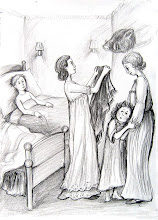Brown, Paul Tolliver. "Relativity, Quantum Physics, and Consciousness in Virginia Woolf’s To the Lighthouse." Journal of Modern Literature 32.3 (2009): 39-62.
Virginia Woolf’s philosophies reflect the theories of Albert Einstein and Quantum Physics, in specific the theory of the wave-particle duality of light and matter. Brown notes that when creating her most important novel characters, Woolf opted for creating their point of view in a manner that reflected hers. He observes that as a child, Woolf was exposed to these philosophies through her father, who is portrayed as Mr. Ramsay in To the Lighthouse. Lily Briscoe’s views were shaped in the same manner by Woolf’s experiences. Lily is shown to have the issues of objectivity and realism as a prominent thought, which was reflected with Lily’s questioning if a table exists even if it cannot be seen. Her father’s influence was not obsolete; Woolf had ideas that differed from her father, which also were reflected in Lily Briscoe through her mental activity when painting.
This article helps the reader to understand the similarities shared by Woolf and Lily when producing their art, whether it was painting or writing. The narrative style is able to grasp a hold of the reader’s attention by connecting the similarities that Woolf and Lily have as artists and their manners of portraying those through their art. The readers experience is enhanced when it is understood that the author and creator of the main character of To the Lighthouse, Lily Briscoe, has used her life experiences when shaping her. Understanding Woolf’s past and the influence that her father and his philosophies had on her allow readers to be conscious of how Lily’s thoughts when painting reflect the narrative style that Woolf uses to portray Lily’s paintings. Consciously reading this novel with these things in mind allow the reader to withhold judgment against the characters and at the same time allow them to understand the creative process that artists experience when creating their masterpieces. Knowing some of the background that shape the characters can provide a clearer understanding of their actions and attitudes within the novels.
Subscribe to:
Post Comments (Atom)



No comments:
Post a Comment